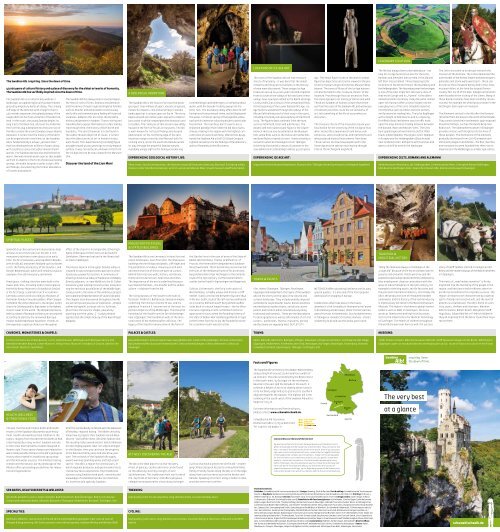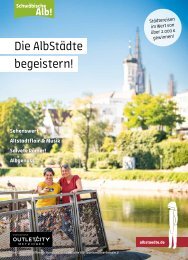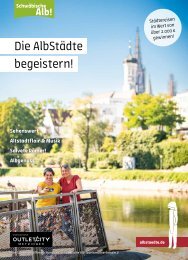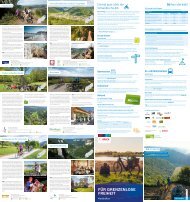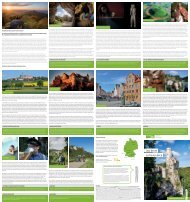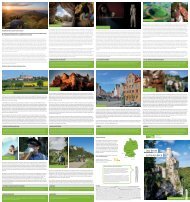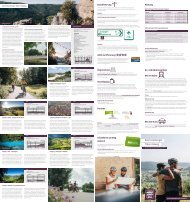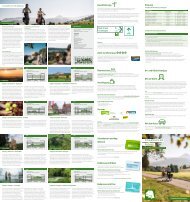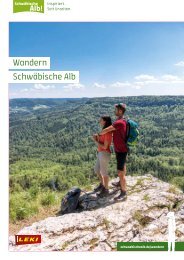Highlight Map Swabian Alb • The Very Best At A Glance
The Swabian Alb, a region in the Southwest of Germany, is rich in history, nature and culinary delight. Discover the most beautiful destinations of the Swabian Alb: Our overview map provides you with tips and information about where to travel. A journey through time - from prehistoric eras to today. ➜ For more information: swabianalb.info
The Swabian Alb, a region in the Southwest of Germany, is rich in history, nature and culinary delight.
Discover the most beautiful destinations of the Swabian Alb: Our overview map provides you with tips and information about where to travel. A journey through time - from prehistoric eras to today.
➜ For more information: swabianalb.info
Create successful ePaper yourself
Turn your PDF publications into a flip-book with our unique Google optimized e-Paper software.
LEGENDARY LOCATIONS<br />
<strong>The</strong> <strong>Swabian</strong> <strong>Alb</strong>. Inspiring. Since the dawn of time.<br />
40,000 years of cultural history and a place of discovery for the oldest artworks of humanity.<br />
<strong>The</strong> <strong>Swabian</strong> <strong>Alb</strong> has verifiably inspired since the dawn of time.<br />
<strong>The</strong> <strong>Swabian</strong> <strong>Alb</strong> is a romantically wild karst<br />
landscape, an upland region with juniper heaths<br />
grazed by migratory herds of sheep. <strong>The</strong> striking<br />
cliff edge of the <strong>Alb</strong>trauf with a height of up to<br />
400 metres separates the upland plateau of the<br />
rough <strong>Alb</strong> from the fruit orchards of the <strong>Alb</strong> foreland.<br />
In the south, the young Danube begins its<br />
long trip to the Black Sea, and over the millennia<br />
the river has dug a deep bed into the Jura rock of<br />
the <strong>Alb</strong> to create the scenic Danube canyon Oberes<br />
Donautal. It is here that the history of the Earth<br />
can be experienced in real time, as the <strong>Swabian</strong><br />
<strong>Alb</strong> is fundamentally a unique „Jurassic Park“<br />
that has developed over millions of years along<br />
with countless caves and subterranean dream<br />
worlds. <strong>The</strong> <strong>Swabian</strong> <strong>Alb</strong> has also maintained its<br />
warm, thermal mineral water sources that bubble<br />
up from its depths in the form of precious healing<br />
springs. Veritable fairytale castles crown cliffs<br />
and hilltops, documenting the former abundance<br />
of castles and palaces.<br />
<strong>The</strong> <strong>Swabian</strong> <strong>Alb</strong> has always been a coveted region –<br />
the historic sites of Celts, Romans and Alemanni<br />
and the names of major royal and imperial families<br />
such as Staufer and Hohenzollern conclusively<br />
verify this and communicate a feeling of historical<br />
vividness. Added to this are cities that breathe<br />
history and present in tandem. Those visiting and<br />
travelling here expose themselves to a fascinating<br />
trip through time, the history of both Earth and<br />
humanity. <strong>The</strong> secret however is to be found in<br />
the subterranean labyrinth of caves: it is here<br />
that the oldest works of art in human history<br />
were found. <strong>The</strong> Löwenmensch [Lion Man] figure<br />
wrought around 40,000 years ago is a truly magical<br />
symbol. It was carved by an unknown artist from<br />
the Ice Age and can be now viewed in the Museum<br />
Ulm.<br />
Discover the land of the Lion Man!<br />
A GEOLOGICAL ADVENTURE<br />
<strong>The</strong> <strong>Swabian</strong> <strong>Alb</strong> is the result of an eventful geological<br />
past. Over millions of years, volcanic eruptions,<br />
meteorite impacts, rain and wind have created a<br />
landscape that is unique upon our Earth. <strong>The</strong> story<br />
begins around 200 million years ago with a tropical<br />
Jura ocean in which romped genuine dinosaurs and<br />
crocodiles. <strong>The</strong> creatures of that era are now safely<br />
housed in the form of fossils in museums. <strong>The</strong> <strong>Alb</strong><br />
is well-known for its fossil findings and natural<br />
phenomena: on the northerly edge of the Jura<br />
mountain range stretches the <strong>Alb</strong>trauf with its<br />
striking scarp, and in the south the Danube winds<br />
its way through the powerful Danube canyon.<br />
A globally unique sight is the Donauversickerung<br />
at Immendingen and Möhringen: a riverbed without<br />
water, with the Danube trickling away into the<br />
karst rock. <strong>The</strong> Eselsburg valley offers bizarre cliff<br />
formations from primeval times, and in Blaubeuren<br />
the water-rich karst spring of the legendary Blautopf<br />
with its intensive colouring exudes a particular<br />
fascination. <strong>The</strong> countless karst caverns are a<br />
dripstone paradise that riddle the <strong>Alb</strong> like a Swiss<br />
cheese, making it the region with the highest concentration<br />
of caves in Germany. UNESCO has designated<br />
the <strong>Swabian</strong> <strong>Alb</strong> a UNESCO Global Geopark.<br />
A global sensation are the findings of the oldest artworks<br />
of humanity in the <strong>Alb</strong> caverns.<br />
LOCATIONS OF ICE AGE ART<br />
<strong>The</strong> caves of the <strong>Swabian</strong> <strong>Alb</strong> are true treasure<br />
chests of humanity – it was here that the oldest<br />
artworks and musical instruments in the history<br />
of man were discovered. <strong>The</strong>se unique Ice Age<br />
treasures are up to 40,000 years old and originate<br />
from six caves in the valleys of Ach and Lone; these<br />
valleys have now been added to the World Heritage<br />
List by UNESCO as a result of the sensational finds.<br />
<strong>At</strong> the beginning of the Lower Palaeolithic Age, Ice<br />
Age hunters wandered through the valleys of the<br />
<strong>Alb</strong> and left behind proof of their stay in the caves,<br />
including artistically carved sculptures of mammoth<br />
ivory. <strong>The</strong> figures depict animals from the hunt<br />
such as mammoth, bison and wild horses. <strong>The</strong><br />
largest and most spectacular figure is the Löwenmensch<br />
that can now be admired in the Museum<br />
Ulm, while finds such as the Venus vom Hohle Fels<br />
and bone flutes created a furore. It was certainly a<br />
sensation when archaeologists from Tübingen<br />
University discovered a statue of a woman in the<br />
cave Hohle Fels in 2008 dating to almost 40,000 years<br />
ago. <strong>The</strong> Venus figure is one of the world‘s oldest<br />
figurative depictions and can be viewed in the prehistoric<br />
museum Urgeschichtliches Museum Blaubeuren.<br />
<strong>The</strong> tones of flutes of the Ice Age hunters<br />
can also be heard in the „treasure chests“ of the<br />
museum. Proof enough that our ancestors from<br />
the Stone Age were not merely primitive and wild!<br />
<strong>The</strong>se are lullabies of human culture that chime<br />
out from the caves of the <strong>Swabian</strong> <strong>Alb</strong>, and witnesses<br />
of a distant past that, as do the carved works of<br />
art, tell something of the life of our prehistoric<br />
ancestors...<br />
<strong>The</strong> treasure chests of the museums arouse your<br />
fascination for the creativity of the Ice Age artists<br />
who created the Löwenmensch and Venus vom<br />
Hohle Fels, who carved horses and mammoths and<br />
who produced musical instruments from bone.<br />
Those curious to know how people lived in the<br />
Stone Age era can take an exciting trip through<br />
time at the Archäopark Vogelherd.<br />
<strong>The</strong> <strong>Alb</strong> has always been a desirable place – not<br />
only for Ice Age hunters but also for the Celts,<br />
Romans and Alemanni who settled in the <strong>Alb</strong> and<br />
left their traces behind. Three imposing Celtic<br />
locations on the <strong>Alb</strong> are the Ipf, the Heuneburg and<br />
the Heidengraben. <strong>The</strong> Heuneburg near Herbertingen<br />
is one of the most important discovery sites of<br />
that era in Europe and its „Pyrene“ is the oldest<br />
named location in Germany. Today the same-named<br />
open-air museum offers a clear insight into the<br />
everyday lives of the Celts. Valuable imported<br />
merchandise such as amber and <strong>At</strong>tic pottery<br />
verify extensive trading links. <strong>The</strong> Ipf at Bopfingen<br />
with a height of 668 metres and its imposing,<br />
fortified hilltop settlement was a traffic node<br />
upon the long-distance trading network between<br />
the Danube, Main and Neckar rivers. <strong>The</strong> Celts<br />
built quadrangle entrenchments and fortified<br />
towns (called Oppida). <strong>The</strong> largest Celtic Oppidum<br />
in Europe was the Heidengraben (Elsachstadt)<br />
near Grabenstetten. Ramparts with trenches and<br />
gates can still be seen in the landscape.<br />
EXPERIENCING GEOLOGICAL HISTORY LIVE: EXPERIENCING ICE AGE ART: EXPERIENCING CELTS, ROMANS AND ALEMANNI<br />
Show caves, fossil hunting areas, the Danube canyon & Donauversickerung, Blautopf, Eselsburg valley,<br />
meteor crater Steinheimer Becken, extinct vulcano Randecker Maar, Urweltmuseum Hauff Holzmaden<br />
Urgeschichtliches Museum Blaubeuren, Museum Ulm, Tübingen University museum, Archäopark Vogelherd<br />
<strong>The</strong> Celtic era came to an abrupt end with the<br />
invasion of the Romans. <strong>The</strong> Limes delineated the<br />
outer border of the Roman Empire and watchtowers,<br />
palisades and stone walls were built – these can<br />
be seen at the Limespark Rainau and in the Limesmuseum<br />
Aalen, at the time the largest Roman<br />
cavalry fort north of the Alps. Villages and estates<br />
were founded in the vicinity of the Limes. Many of<br />
these Roman remains have been carefully reconstructed,<br />
for example the Villa Rustica estate in the<br />
Hechingen-Stein open-air museum.<br />
<strong>The</strong> Alemanni settled in the <strong>Alb</strong> after the Romans<br />
retreated from the areas to the north of the Danube.<br />
<strong>The</strong>y constructed their settlements upon exposed<br />
mountain hilltops, such as the Runde Berg near<br />
Bad Urach. <strong>The</strong> Alamannenmuseum in Ellwangen<br />
provides visitors with insights into the lives of<br />
these peoples. <strong>The</strong> dominance of the Alemanni<br />
gradually decreased from 500 AD onwards and<br />
Christianity began to proliferate – the first churches<br />
and monasteries were founded that then rose to<br />
importance in the Middle Ages as intellectual centres.<br />
Keltenmuseum Heuneburg, Ipf, Heidengraben, Limesmuseum Aalen, Limespark Rainau-Dalkingen,<br />
Villa Rustica Hechingen-Stein, Deutsche Limesstraße, Alamannenmuseum Ellwangen<br />
SPIRITUAL PLACES<br />
Splendid churches and ancient monasteries bear<br />
witness to an artistic past on the <strong>Alb</strong>. A rich<br />
monastery existence came about at an early<br />
time: the first monastery was founded in Blaubeuren<br />
in 1085 AD, and others followed such as Kloster<br />
Lorch, the family monastery of the Staufers, and<br />
Kloster Bebenhausen, which still remains a typical<br />
example of an old monastery settlement.<br />
Prestigious, striking churches were built in the<br />
towns and cities, including Gothic masterpieces:<br />
the Heilig-Kreuz-Münster in Schwäbisch Gmünd<br />
is the first large-scale hall church in southern<br />
Germany constructed according to the plans of<br />
the Parler family of master builders. After Cologne<br />
Cathedral the Ulmer Münster is the largest Gothic<br />
church in Germany and its high tower is the highest<br />
church tower in the world. <strong>The</strong> Abteikirche Neresheim<br />
is a jewel of Baroque architecture constructed<br />
according to plans by the renowned Baroque<br />
master builder Balthasar Neumann. Thanks to<br />
the ingenious cupola architecture the spatial<br />
effect of the church is incomparable. Other highlights<br />
of Baroque architecture can be found in<br />
Zwiefalten, Obermarchtal and in the library hall<br />
at Kloster Wiblingen.<br />
<strong>The</strong> Kloster Beuron in the upper Danube valley is<br />
situated in a picturesque landscape and is simultaneously<br />
a powerful location. A community of<br />
around 50 monks live today in the Beuron archabbey.<br />
Directly adjacent, i.e. near Meßkirch, the St. Gallen<br />
monastery plan is being reconstructed, incorporating<br />
the technical possibilities of the Middle Ages.<br />
Campus Galli is the name of the ambitious project<br />
with a planned implementation of several decades.<br />
<strong>The</strong> chapels to be discovered throughout the <strong>Alb</strong><br />
are secret tips and sources of inspiration. „Droben<br />
stehet die Kapelle, schauet still ins Tal hinab…“<br />
[Over there thrones the chapel, peacefully<br />
watching over the valley...] – Ludwig Uhland<br />
appreciated the simple beauty of the Wurmlinger<br />
Kappelle.<br />
PROUD FORTIFICATIONS<br />
& STATELY BUILDINGS<br />
<strong>The</strong> <strong>Swabian</strong> <strong>Alb</strong> is one Germany‘s richest fort and<br />
castle landscapes. Seen from afar, the impressive<br />
buildings throne hilltops and peaks, cliff edges and<br />
the peripheries of valleys. Around 400 still exist<br />
and more than 100 of these are open to visitors.<br />
Behind their massive walls, history, narrations,<br />
theme and costume tours help relive old times.<br />
<strong>The</strong> importance of the era is underlined because<br />
two imperial families – the Staufer and the Hohenzollern<br />
– originate from the <strong>Alb</strong>.<br />
<strong>The</strong> ruling dynasty of the Staufer continues to<br />
fascinate. Friedrich I. Barbarossa created an empire<br />
stretching from Sicily to the North Sea, and his<br />
grandson Friedrich II. became one of the most important<br />
emperors of the Middle Ages. <strong>The</strong> ancestral<br />
homeland of the Staufer are the Drei Kaiserberge<br />
near Göppingen; the foundation walls of the ancestral<br />
castle of the Hohenstaufen still exist. <strong>The</strong><br />
legacy of the Staufer remains alive in the form of<br />
the Staufer lions in the coat of arms of the State of<br />
Baden-Württemberg. Thanks to Wilhelm IV. of<br />
Prussia, the Hohenzollern bequeathed a <strong>Swabian</strong><br />
Neuschwanstein. <strong>The</strong> Prussian king reconstructed<br />
the ruins of the mediaeval home of his ancestors,<br />
Burg Hohenzollern near Hechingen, in the romantic<br />
style of the 19th century. Further Hohenzollern<br />
castles can be found in Sigmaringen and Haigerloch.<br />
Schloss Lichtenstein, the fairy-tale castle of<br />
Württemberg, is highly unique and thrones a cliff<br />
needle: it was constructed between 1840 and 1842<br />
in the neo-Gothic style of the 19th century and based<br />
on a novel by Wilhelm Hauff. Burg Hohenneuffen<br />
looks back on a much longer history – the fortification<br />
was originally a Celtic settlement and once<br />
again wrote history when the founding fathers of<br />
the State of Baden-Württemberg gathered in 1948<br />
at the former fortress to lay the foundation stone<br />
for a common south-western state.<br />
TOWNS & EVENTS<br />
Ulm, Aalen, Ellwangen, Tübingen, Reutlingen,<br />
Göppingen and Heidenheim: the towns of the <strong>Swabian</strong><br />
<strong>Alb</strong> are the cherry on the cake of its natural and<br />
cultural landscape. <strong>The</strong>y include wealthy imperial<br />
settlements, Royal Staufer towns, Roman locations<br />
and mediaeval market towns, and all are cosmopolitan<br />
and modern while simultaneously being<br />
traditional and romantic. <strong>The</strong>se are the ideal places<br />
for photographers as well as aficionados of art and<br />
culture – exhibitions, theatre, museums, parties<br />
and festivals are regularly held. OUTLETCITY<br />
METZINGEN offers pulsating liveliness and its own,<br />
special quality - it‘s also one of the most popular<br />
addresses for shopping in Europe.<br />
Celebrations often take place in the towns:<br />
whether it‘s the Schwäbisch-Alemannische Fasnet<br />
in Rottenburg and Rottweil, Ulmer Fischerstechen,<br />
opera festivals in Heidenheim, Stocherkahnrennen<br />
in Tübingen or romantic Christmas markets – there‘s<br />
something to do and see the whole year round.<br />
TRADITION &<br />
INDUSTRIAL HISTORY<br />
Tilling the land was always a challenge on the<br />
„rough <strong>Alb</strong>“ because of the harsh climate, barren<br />
ground, rain and wind. Yields were low and the<br />
population were subjected to harshness and poverty.<br />
New employment chances came about with the<br />
wave of industrialisation in the 19th century, for<br />
example in smelting works, textile factories and<br />
the precision mechanical industry. Until today the<br />
<strong>Alb</strong> is the production site of renowned branded<br />
underwear, and the history of the textile industry<br />
is impressively narrated in the Maschenmuseum<br />
<strong>Alb</strong>stadt. <strong>The</strong> region is the home to global market<br />
leaders such as WMF in Geislingen, the Zeiss<br />
works at Oberkochen and high-tech locations<br />
such as the Global Centre for Medical Technology<br />
at Tuttlingen. <strong>The</strong> hearts of children throughout<br />
the world are won over here as well: the success<br />
story of Steiff teddies started in Giengen an der<br />
Brenz and the model railways of the Märklin brothers<br />
in Göppingen.<br />
<strong>The</strong> motto of „need makes inventive“ is firmly<br />
engrained into the mentality of the people in the<br />
region, and hard work and thriftiness were important<br />
preconditions for corporate success. <strong>The</strong><br />
region continues to be characterised by a special<br />
spirit of design and creative will, and the level of<br />
patents is unsurpassed. <strong>The</strong> <strong>Alb</strong> is home to scientists,<br />
poets, thinkers and inventors. Whether<br />
<strong>Alb</strong>ert Einstein, Robert Bosch, Margarete Steiff,<br />
Hugo Boss, Eduard Mörike or Friedrich Hölderlin:<br />
they all originate from the <strong>Alb</strong> or found their inspiration<br />
there.<br />
CHURCHES, MONASTERIES & CHAPELS:<br />
PALACES & CASTLES:<br />
TOWNS:<br />
MUSEUMS:<br />
Former monasteries of Blaubeuren, Lorch, Bebenhausen, Wiblingen with Baroque library hall,<br />
Benediktinerabtei Beuron, Ulmer Münster, Heilig-Kreuz-Münster Schwäbisch Gmünd, Abteikirche<br />
Neresheim, Münster Zwiefalten<br />
Burg Hohenzollern, Schloss Sigmaringen, Burg Wildenstein, Zollernschloss Balingen, Schloss Lichtenstein,<br />
Burg Hohenneuffen, Burgruine Hohenstaufen, Schloss Hohentübingen, Schloss Hellenstein, Schloss ob<br />
Ellwangen<br />
Aalen, <strong>Alb</strong>stadt, Bad Urach, Balingen, Ehingen, Ellwangen, Giengen an der Brenz, Geislingen an der Steige,<br />
Göppingen, Heidenheim, Kirchheim unter Teck, Metzingen, Nürtingen, Reutlingen, Rottenburg, Rottweil,<br />
Schwäbisch Gmünd, Sigmaringen, Tübingen, Tuttlingen, Ulm<br />
Tiefer Stollen at Aalen, Maschenmuseum <strong>Alb</strong>stadt, Steiff-Museum Giengen an der Brenz, Märklineum<br />
Göppingen, open-air museums Beuren and Neuhausen ob Eck, route of industrial culture in the Filstal<br />
Facts and Figures<br />
HEALTH, WELLNESS<br />
& TRADITIONAL FOOD<br />
<strong>The</strong> spa, thermal and mineral baths and health<br />
resorts of the <strong>Swabian</strong> <strong>Alb</strong> promise pure enjoyment.<br />
Health and wellness have tradition in the<br />
region, ranging from the <strong>Alb</strong> thermal baths at Bad<br />
Urach heated by a long-extinct <strong>Swabian</strong> volcano<br />
to the Limes thermal baths at Aalen designed in<br />
Roman style. <strong>The</strong>se oases of peace and relaxation<br />
were made possible thanks to the <strong>Alb</strong>‘s geological<br />
history that created its traditional spa springs<br />
and thermal water sources. <strong>The</strong> mild but bracing<br />
climate and the natural, earthy landscape of the<br />
<strong>Alb</strong> also offer outstanding possibilities for relaxation<br />
and regeneration.<br />
All of this can be ideally combined with the pleasures<br />
of healthy, regional eating. <strong>The</strong> Älbler certainly<br />
know how to prepare their <strong>Swabian</strong> ravioli Maultäschle<br />
– but buffalo meat, <strong>Alb</strong> lamb, Spätzle and<br />
the recently rediscovered ancient lentils <strong>Alb</strong>linsen<br />
are also highly popular. Beer is trump at Ehingen<br />
on the Danube. Here you can trace the progress<br />
of the delicious barley juice and also brew your<br />
own. <strong>The</strong> orchards of the <strong>Swabian</strong> <strong>Alb</strong> supply<br />
award-winning sparkling wines and high-proof<br />
spirits – the <strong>Alb</strong> is a region for connoisseurs, in<br />
which regional producers and gastronomic hosts<br />
create new taste experiences from traditional<br />
sources using <strong>Swabian</strong> hard work, creativity and<br />
knowledge of established production methods.<br />
It’s inventive and typically <strong>Swabian</strong>...<br />
ACTIVELY DISCOVERING THE ALB<br />
<strong>The</strong> <strong>Alb</strong> is the ideal place for active recovery.<br />
A host of palaces, castles and ruins can be found<br />
on the <strong>Alb</strong>steig covering a length of over<br />
350 kilometres. This traditional main trail is one of<br />
the „Top Trails of Germany“ and offers gorgeous<br />
viewpoints and panoramic vistas along its length.<br />
Cyclists also have a great time on the <strong>Alb</strong> – challenging<br />
climbs and quick descents on mountain bikes,<br />
family-friendly routes along the <strong>Alb</strong>, or on the edge<br />
along rivers and currents such as the Neckar and<br />
Danube. Speaking of current: using a modern E-bike<br />
provides even more comfort.<br />
<strong>The</strong> <strong>Swabian</strong> <strong>Alb</strong> stretches across Baden-Württemberg<br />
along a length of around 220 km and has a width of<br />
up to 80 km. <strong>The</strong> area is bordered by the Black Forest<br />
in the south-west, by Stuttgart in the northwest,<br />
Bavaria in the east and the Danube in the south. It<br />
achieves a height of 700 m to slightly above 1,000 m<br />
at its northerly edge and up to 500 m at its southern<br />
edge and towards the Danube. <strong>The</strong> highest hill is the<br />
Lemberg in the south-west of the <strong>Swabian</strong> <strong>Alb</strong> with a<br />
height of 1,015 m.<br />
For more information and free brochures,<br />
please contact www.schwaebischealb.de.<br />
Schwäbische <strong>Alb</strong> Tourismus<br />
Bismarckstraße 21 | 72574 Bad Urach<br />
Tel. +49 (0) 7125 93930-0<br />
Come and discover the land of the lion man!<br />
France<br />
Cologne<br />
Switzerland<br />
Frankfurt<br />
Stuttgart<br />
<strong>Swabian</strong> <strong>Alb</strong><br />
My land can be found in the South between Bavaria and the Black Forest.<br />
Where the Danube and the Neckar are still primordial. <strong>The</strong>y call me the lion<br />
man. I am one of the oldest works of art in the world. Around 40,000 years<br />
ago I was created using mammoth ivory, inspired by the rugged landscape<br />
of the <strong>Swabian</strong> <strong>Alb</strong>‘s mighty Karst mountains. Today I am the ambassador<br />
for this land which can sometimes be harsh, yet also gentle. Sometimes<br />
majestic, sometimes mysterious. <strong>The</strong> land in which people were canny<br />
before time began. Be canny along your way too. Follow me and let yourself<br />
be struck by the incomparable beauty, by mountains and castles of<br />
powerful emperors and kings, by the legendary arenas of the Romans and<br />
Celts and by proud cities which live the past and the future simultaneously.<br />
Hamburg<br />
Munich<br />
Austria<br />
Berlin<br />
<strong>The</strong> very best<br />
at a glance<br />
SPA BATHS, HEALTH RESORTS & WELLNESS:<br />
Spa baths & health resorts: Aalen, Bad Boll, Bad Ditzenbach, Bad Überkingen, Bad Urach, Beuren.<br />
Leisure and relaxation baths: <strong>Alb</strong>stadt, Blaustein, Ellwangen, Heidenheim, Rottweil, Tuttlingen, Ulm.<br />
SPECIALITIES:<br />
<strong>Alb</strong>linsen, <strong>Alb</strong>lamm, restaurants of the <strong>Alb</strong>-Wirte and Biosphärengastgeber, beer culture town of<br />
Ehingen & Berg brewery, <strong>Alb</strong>-Gold customer centre & herb garden, <strong>Swabian</strong> Whisky and Whisky-Walk<br />
TREKKING:<br />
High quality trails for one-day hikes, long-distance trails, circular and daily tours<br />
CYCLING:<br />
High quality cycle routes, long-distance cycle routes, mountain biking, E-bike tours, bike parks and MTB<br />
events<br />
Publication details:<br />
Publisher: Schwäbische <strong>Alb</strong> Tourismusverband e.V. Design: Benning, Gluth & Partner Text & editing: Schwäbische <strong>Alb</strong> Tourismusverband<br />
e.V. <strong>Map</strong> basis: Outdooractive Kartografie Geoinformationen © Outdooractive © GeoBasis-DE / BKG 2017 Printing: SV Druck +<br />
Medien GmbH & Co. KG, Balingen Version: November 2019, errors and modifications reserved Image credits: Cover image: Schloss<br />
Lichtenstein, © Manuel Schönfeld/fotolia.com © Schwäbische <strong>Alb</strong> Tourismus/photos: Achim Mende, Günther Bayerl, Julia Metzmann,<br />
Ralph Lueger, Manfred Grohe, Thomas Rathay | Alamannenmuseum Ellwangen, <strong>Alb</strong>stadt Tourismus/Volker Bitzer, Archäologisches<br />
Landesmuseum Baden-Württemberg, „Die Staufer“ exhibition/ <strong>At</strong>elier Alexy, Bad Urach Tourismus, Burg Katzenstein/ Roswitha Walter,<br />
Campus Galli, Donaubergland GmbH, Donaubergland GmbH/<strong>Best</strong> of Wandern, Dr. Bernhard Hildebrandt, FLM Neuhausen ob Eck/<br />
Karl-Heinz Reizner, Guido Serino Photography, Marbach/Max Schreiner main and rural stud, Höhlenverein Giengen-Hürben e.V./<br />
Heinz Nemela, Jürgen Ranger, Bebenhausen monastery and castle, Margarete Steiff GmbH, OUTLETCITY METZINGEN, Peter Seidel, Roland<br />
Beck/Burg Hohenzollern, Thomas Blank, Touristik-Gemeinschaft Stauferland, Ulm/Neu-Ulm Touristik GmbH, Ulrich Sauerborn/<br />
Limesmuseum Aalen, Urgeschichtliches Museum Blaubeuren/Günther Bayerl, Urweltmuseum Hauff, Wandermagazin/Klaus-Peter Kappest,<br />
Yvonne Mühleis/LAD Esslingen, PixelPower/fotolia.com | Corporations: Bad Boll, Herbertingen, Sonnenbühl | District offices:<br />
<strong>Alb</strong>-Donau and Heidenheim/burkert, Esslingen/ Dieter Ruoff, Heidenheim/Guido Serino, Ostalbkreis/ Katja Beyer | Towns: Aalen,<br />
Blaubeuren, Ehingen, Ellwangen, Haigerloch/Egidius Fechter, Heidenheim, Mössingen/Uwe Walz, Münsingen, Neresheim<br />
schwaebischealb.de
Schmiech<br />
<strong>Swabian</strong> <strong>Alb</strong><br />
PANORAMA VIEWS<br />
Lemberg 1<br />
with 1,015 m is the highest<br />
mountain of the <strong>Swabian</strong> <strong>Alb</strong><br />
Zeller Horn 2<br />
View of Burg Hohenzollern<br />
Dreifürstenstein 3<br />
Breitenstein 4<br />
Hausener Wand 5<br />
Rosenstein 6<br />
Ipf 7<br />
Witthoh 14<br />
THE ALBTRAUF –<br />
THE BLUE WALL<br />
<strong>The</strong> <strong>Alb</strong> was already a dream<br />
destination for Eduard Mörike.<br />
<strong>The</strong> poet, with a sense of yearning, used<br />
the words of „wonderful blue wall“ to<br />
describe the powerful, almost 200 kilometrelong<br />
cliff edge of the <strong>Alb</strong>trauf that soars to<br />
heights of up to 1,000 metres. It separates the<br />
high plateau of the „rough <strong>Alb</strong>“ from the<br />
more mellifluous orchards of the <strong>Alb</strong><br />
foreland. Wonderful views towards the<br />
<strong>Alb</strong> foreland can be experienced<br />
along the complete route of<br />
the <strong>Alb</strong>trauf.<br />
MÖSSINGER<br />
BERGRUTSCH<br />
A national geotope<br />
created in 1983<br />
following Baden-<br />
Württemberg‘s<br />
largest landslide.<br />
THERMAL BATHS<br />
ON THE ALBTRAUF<br />
True springs of health are<br />
the warm thermal and mineral<br />
water resources from the<br />
depths of the <strong>Alb</strong> which are<br />
most probably the aftereffects<br />
of volcanic<br />
activity from the<br />
Tertiary Period.<br />
TÜBINGEN<br />
SCHLOSS<br />
LICHTENSTEIN<br />
Württemberg‘s „fairytale<br />
castle“ was constructed<br />
after a novel by Wilhelm<br />
Hauff and thrones one of<br />
the most attractive<br />
locations on the <strong>Alb</strong>.<br />
An old, historical town<br />
situated on the Neckar river<br />
with the pulsating life of a<br />
young and cosmopolitan<br />
university city: Tübingen is<br />
one of the most attractive<br />
towns in Germany.<br />
OUTLETCITY<br />
METZINGEN<br />
A unique shopping<br />
experience located in the<br />
home town of Hugo Boss<br />
between half-timbered<br />
houses, winegrowing and<br />
modern architecture.<br />
URACH<br />
WATERFALL<br />
<strong>The</strong> natural spectacle<br />
of the Urach Waterfall<br />
plummets over a tuff<br />
cliff to a depth of<br />
37 metres.<br />
BURG<br />
HOHENNEUFFEN<br />
Mighty and seen from<br />
afar: the former fortress<br />
is the largest castle<br />
ruins in southern<br />
Germany.<br />
4<br />
5<br />
URWELTMUSEUM<br />
HAUFF<br />
On the tracks of<br />
dinosaurs and sea lilies:<br />
the Hauff private<br />
collection houses some<br />
of the world‘s best<br />
fossils.<br />
6<br />
HOHENSTAUFEN CASTLE RUINS<br />
AND THE DREI KAISERBERGE<br />
<strong>The</strong> Drei-Kaiserberge of<br />
Hohenstaufen, Stuifen and<br />
Rechberg situated in the <strong>Alb</strong><br />
foreland resemble the humps of a<br />
camel – the Hohenstaufen is the<br />
ancestral home of the Staufer,<br />
once one of the most powerful<br />
of the royal families.<br />
7<br />
UNESCO WORLD<br />
HERITAGE OF LIMES<br />
After the Chinese Wall, the<br />
UNESCO world heritage site<br />
of Limes is the longest ground<br />
memorial in the world. Many<br />
Roman traces can be found on<br />
the <strong>Alb</strong>: the Limesmuseum<br />
Aalen and the Limespark<br />
Rainau-Dalkingen.<br />
KLOSTER<br />
NERESHEIM<br />
STEIFF MUSEUM<br />
GIENGEN<br />
<strong>The</strong> home of the teddy<br />
bear. It conquered the rest<br />
of the world from this<br />
location, and the Steiff<br />
Museum tells the story<br />
of its success.<br />
This abbey church, a jewel<br />
of Baroque architecture,<br />
was constructed according<br />
to plans of the famous<br />
master builder Balthasar<br />
Neumann.<br />
ESELSBURG<br />
VALLEY<br />
Bizarre cliff formations<br />
are typical of the <strong>Alb</strong>: the<br />
Steinerne Jungfrauen [stone<br />
virgins] in the Eselsburger<br />
Tal were, according to<br />
legend, enchanted by<br />
an angry castle<br />
damsel.<br />
ATOMKELLER-<br />
MUSEUM HAIGERLOCH<br />
A true-to-original<br />
reconstruction of the first<br />
atomic reactor in the former<br />
cave research laboratory of the<br />
rocky lilac town of Haigerloch,<br />
a Baroque gem and „cradle of<br />
atomic research“.<br />
BURG<br />
HOHENZOLLERN<br />
<strong>The</strong> „<strong>Swabian</strong> Neuschwanstein“<br />
– the<br />
ancestral home of the<br />
Hohenzollern and the<br />
Prussian royal family –<br />
majestically thrones a<br />
hilltop peak of<br />
855 metres.<br />
OBERES DONAUTAL<br />
AND KLOSTER BEURON<br />
A baroque cultural<br />
treasure in the valley of<br />
the young Danube: the<br />
Benedictine monastery still<br />
remains a lively place of faith.<br />
Mediaeval fortresses such as<br />
the attractively located Burg<br />
Wildenstein stand proudly<br />
on the cliffs above the<br />
Danube valley.<br />
HÖHLENWELTEN<br />
SONNENBÜHL<br />
<strong>The</strong> fabled subterranean<br />
worlds of the Bärenhöhle<br />
and Nebelhöhle caves: show<br />
caves with fantastic subterranean<br />
halls and splendid<br />
stalactites.<br />
CAMPUS GALLI<br />
11<br />
Near Meßkirch the St. Gallen<br />
monastery plan is being<br />
reconstructed, incorporating the<br />
technical possibilities of the<br />
Middle Ages. Campus Galli is the<br />
name of the ambitious project<br />
with a planned implementation<br />
of several decades.<br />
1<br />
Eyach<br />
14<br />
SCHLOSS<br />
SIGMARINGEN<br />
13<br />
<strong>The</strong> home of the princes<br />
of Hohenzollern-<br />
Sigmaringen is located on<br />
a mighty Jurassic cliff<br />
above the Danube.<br />
12<br />
2<br />
3<br />
10<br />
HAUPT- UND<br />
LANDGESTÜT MARBACH<br />
With a history of over<br />
500 years, Haupt- und<br />
Landgestüt Marbach is<br />
the oldest German state<br />
stud, and also a stud<br />
museum at<br />
Offenhausen.<br />
Donau<br />
9<br />
GROSSES<br />
LAUTERTAL<br />
<strong>The</strong> charming valley<br />
Großes Lautertal is<br />
the location of<br />
20 castles and<br />
castle ruins.<br />
UNESCO WORLD HERITAGE<br />
‘CAVES AND ICE AGE ART’<br />
Six caves located in the valleys<br />
of Ach and Lone were declared<br />
world heritage sites by UNESCO –<br />
it was here that the oldest artworks<br />
of humanity were found,<br />
including the Löwenmensch<br />
[Lyon Man]carved from<br />
mammoth ivory.<br />
8<br />
„GRAND CANYON“-VIEWS<br />
ULMER<br />
MÜNSTER<br />
A trip to Ulm is highly<br />
recommended:<br />
the Ulmer Münster<br />
church tower with a<br />
height of 162 metres<br />
is the world‘s<br />
highest.<br />
BLAUTOPF<br />
BLAUBEUREN<br />
<strong>The</strong> most attractive<br />
karst spring in Germany<br />
with an enchanting blue<br />
colour, and the location<br />
for many myths and<br />
legends.<br />
HÖHLENERLEBNIS-<br />
WELT GIENGEN<br />
Stone Age adventures<br />
at the Erlebnismuseum<br />
HöhlenSchauLand,<br />
HöhlenHaus and<br />
Charlottenhöhle<br />
JUNIPER HEATHS<br />
AND SHEEP GRAZING<br />
<strong>The</strong> <strong>Swabian</strong> <strong>Alb</strong> exudes a<br />
particular fascination with its<br />
typical juniper heaths traditionally<br />
used for sheep grazing. <strong>The</strong>se require<br />
intensive care through sheep<br />
farming and migratory herding,<br />
and shepherds and their sheep<br />
contribute to maintaining the<br />
cultural landscape.<br />
SWABIAN ALB<br />
BIOSPHERE REGION<br />
<strong>The</strong> biosphere region of the<br />
<strong>Swabian</strong> <strong>Alb</strong> surrounding the former<br />
troop parade ground near Münsingen<br />
consists of 80,000 hectares and is a model<br />
region in terms of commerce and tourism in<br />
harmony with nature and the environment.<br />
<strong>The</strong> heart of the biosphere region officially<br />
recognised by UNESCO beats in Münsingen.<br />
<strong>The</strong> biosphere centre is the best basis for<br />
discovering the former parade ground<br />
with its unique vegetation, and also<br />
the deserted village of Gruorn.<br />
SILVER THISTLE<br />
A plant with symbolic<br />
power: the most wellknown<br />
representative of<br />
<strong>Alb</strong> flora is the silver thistle.<br />
It loves sunny spots,<br />
heathland and sheep<br />
grazing pastures.<br />
Eichfelsen 12<br />
Knopfmacherfelsen<br />
13<br />
PANORAMIC VIEWS<br />
Ulmer Münster 8<br />
Wolfertturm Ehingen 9<br />
Sternbergturm 10<br />
„tyssenkrupp Testurm“ 11<br />
the highest viewing tower<br />
in Germany with a height<br />
of 232 m<br />
Travelling through time on the <strong>Swabian</strong> <strong>Alb</strong><br />
Phytosaur<br />
approx. 200 million<br />
JURASSIC<br />
CRETACEOUS<br />
TERTIARY<br />
Steinheimer Becken<br />
meteorite crater with central rise<br />
approx.<br />
15 million<br />
<strong>Swabian</strong><br />
volcano and<br />
Höwenegg<br />
volcano crater<br />
approx. 18 to 10<br />
million<br />
QUATERNARY<br />
100,000 - 10,000<br />
PRIMAEVAL AND EARLY HISTORY<br />
STONE AGE<br />
NEANDERTHALS<br />
MODERN PEOPLE<br />
Lion Man and other<br />
Ice Age art finds<br />
approx. 40,000<br />
Heuneburg early-Celtic<br />
princely seat<br />
approx. 650<br />
to 450<br />
BRONZE AGE<br />
IRON AGE<br />
CELTS<br />
Celtic gate and<br />
Oppidum Heidengraben<br />
approx. 200<br />
ANTIQUITY<br />
Aalen Roman Fort<br />
approx. 150<br />
THE ROMANS<br />
Alemannic<br />
sheet gold cross<br />
approx. 600 to 800<br />
MIDDLE AGES<br />
THE ALEMANNI<br />
Burg Katzenstein<br />
around 1099<br />
Friedrich I. Barbarossa,<br />
Staufer Emperor 1155 to 1190<br />
HISTORICAL ERA:<br />
ROMANESQUE<br />
STAUFER<br />
Kloster Bebenhausen<br />
founded in 1184<br />
HISTORICAL ERA:<br />
GOTHIC<br />
Ulmer Münster highest<br />
church tower in the world<br />
constructed 1377 to 1890<br />
University of Tübingen<br />
founded in 1477<br />
HOHENZOLLERN<br />
HISTORICAL ERA:<br />
BAROQUE<br />
Münster Zwiefalten,<br />
a Rococo jewel<br />
constructed 1739 to 1765<br />
MODERN ERA<br />
Schloss Lichtenstein<br />
constructed 1840 to<br />
1842 based on a novel<br />
by Wilhelm Hauff<br />
Burg Hohenzollern<br />
reconstructed 1850 to 1867<br />
<strong>Alb</strong>ert Einstein<br />
born 1879 in Ulm<br />
B.C.<br />
A.D.<br />
MODERN ERA<br />
200 million 50,000 500 0<br />
500<br />
1,000 1,500 2,000


